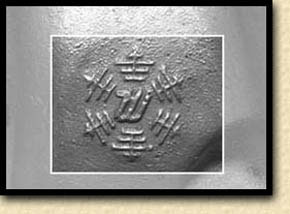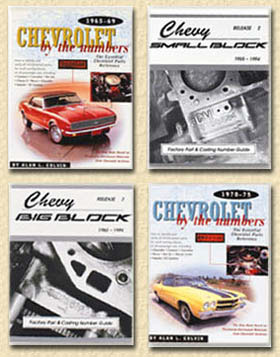
Another exception is found on some aluminum intake
manifolds cast by Winters Industries (those with the famous Winters
snowflake logo). These may appear as more complete dates, such as
3.13.67 (for March 13, 1967). Still other Winters-cast aluminum
intakes will have the more standard alphanumeric
code.
 |
Aluminum intakes
cast by Winters Industries can be identified by the Winters
"Snowflake" logo. |
| Most Winters' date
codes are in this easy-to-read
format. |
Engine Codes - By
deciphering the codes stamped on the pad just below the passenger
side cylinder head, you can determine when, where and for what
application your engine (or block) was built and intended for. For
the most part engine assembly plants used a standard format
throughout the muscle car years which makes decoding much simpler.
The only major change in this code appears on engines built for
1970-and-later models. In these codes an additional identifier was
added, which in the case of Chevrolet was "C" for car and "T" for
truck. The codes appear in the following format:
T0205EG - engines for models
through 1969
V0525CNR - engines for
1970-and-later models
The first character represents the engine
assembly plant. A complete list follows this article. In the case of
our examples, the "T" and "V" represent the Tonawanda, NY and Flint,
Michigan plants respectively. The second and third characters are
the month of assembly ("02" = February and "05" = May in the above
examples), while the fourth and fifth characters represent the day
of assembly ("05" = fifth day of the month and "25" = twenty-fifth
day of the month).
At this point things change a little
depending upon what year model car the engine was intended for use
in. On 1969-and-earlier engines, the sixth and seventh characters
are the engine identification suffix. This suffix denotes the
displacement, horsepower rating and intended model the engine was
built for. In our example, the "EG" denotes a 375-horse 396
special-high-performance engine destined for a Chevelle.
 |
On
1970-and-later engines, the sixth character is the identifier ("C" =
car; "T"=Truck) for the vehicle type, while the seventh and eighth
characters are the engine identification code. In the case of our
second example, "NR" represents a 300-horse 350 to be installed in a
full-size passenger car (Impala/Caprice).
A complete list of
engine ID codes for Chevy II/Novas follows this article. Due to
space constraints we can't publish a more comprehensive list, but
they're available in many of the books found in our Literature
section.
The other numbers stamped on the pad (at least for
'65-and-later models) is the engine V.I.N. This nine-character
number is normally found beside or under the engine code. Stamped
onto the pad by the final assembly plant (where the car is actually
built), the number contains a divisional code (1 = Chevrolet), the
last digit of the year model and a 1-character code (usually a
letter code unless the car was assembled in Canada) for the vehicle
assembly plant. Following these three characters are the last six
digits of the car serial number (known as the sequence number). The
last six digits will match the last six of the car's V.I.N. number
if the engine is original.
Well, there you have it. You can
now determine if that "numbers matching" car really has the right
engine in it. Of course, to be truly numbers matching, the
transmission and rear-axle assembly should be there as well, but
most seem to check the engine only. If you have any questions
regarding these topics, we invite you to call Tech Support staff at Year One
at (800) 950-9503, ext. 172.

For more information on engine and component
identification, we suggest the books shown here. Each title gives
you complete casting number and ID code information, along with
helpful tips on decoding, where to look and what to look for.
 |
